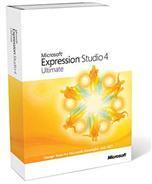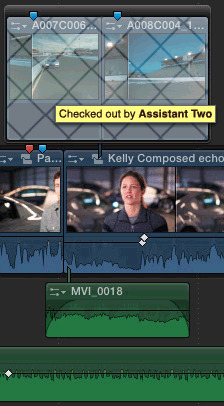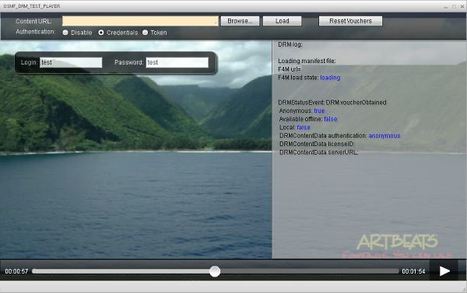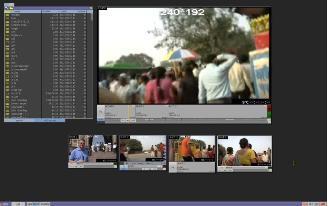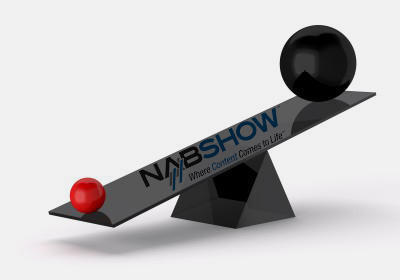 Your new post is loading...
 Your new post is loading...

|
Scooped by
Nicolas Weil
May 20, 2011 5:32 PM
|
AS3 libs for HLS streaming in Flash by Matthew Kaufman - a way of building a decent video player on iOS or the final end of RTMP streaming ?

|
Scooped by
Nicolas Weil
May 16, 2011 5:02 AM
|
Goals of this page :
- Cross-browser video displaying using the new HTML5 Video features
- Fullscreen video in the background
- Catch the new HTML5 Window resize event and adjust the background video size

|
Scooped by
Nicolas Weil
May 14, 2011 6:30 AM
|
Files are displacing videotape and film in acquisition and delivery. This raises the question ‘if we begin with files, post produce files and deliver files, why do we need conventional post and broadcast products? Can’t commodity IT kit do the job?’
The need has never been greater to get costs under control. Increasingly, commodity IT products can do the job -- but there’s growing evidence that to really drive down costs, we have to stop simply dropping IT-based products into conventional post and broadcast architectures and really start to think about business processes. That’s why Service Oriented Architecture (SOA) is now a hot topic. SOA is not a technology but rather a design philosophy widely used outside our industry, write Bruce Devlin and Mark Horton of AmberFin.

|
Scooped by
Nicolas Weil
May 10, 2011 5:56 AM
|
Live video encoding/transcoding software-as-a-service. Transcode your live stream in realtime into web and mobile formats in the cloud.
LiveTranscoding.com offers instant online setup and eliminates the need for costly hardware, software, maintenance, constant upgrades and extensive upload bandwidth. New formats and devices are integrated automatically and the service includes optimized settings for every combination.

|
Scooped by
Nicolas Weil
May 8, 2011 11:55 AM
|
The technology strategy describes the BBC's intent to leverage technologies such as virtualisation, cloud and consumer technologies but the next step was to translate those ambitions into specific areas of technology to start achieving them. We identified 35 different areas of technology and set out to create an individual roadmap or strategy for each. The roadmaps cover all major areas from core infrastructure such as networks and data centres through to content production technology and audience facing such as Red Button and online search. An observation that came from developing the strategies is the importance of enterprise architecture. The BBC is at a tipping point where integration is the focus for both our content production and our enterprise systems. Integration will enable the BBC to deliver efficiencies and better ways of working but it's not trivial to deliver. For the BBC to achieve its goals the role of architectural frameworks, interoperability standards (such as minimal metadata standards) and shared services are vital. Attached to this blog is a summary of all the individual strategy roadmaps. It should provide you with a view of where the BBC would like to focus its efforts across each area of technology. Achieving many of these ambitions is dependant on the relationship the BBC has with technology partners and the innovation and creativity that exists in the market. View presentation here : http://slidesha.re/iChFUk

|
Scooped by
Nicolas Weil
May 5, 2011 10:42 AM
|
VH1 knew that its primarily young and tech-savvy viewers were using mobile devices like the iPhone and iPad to share information with their friends while watching its shows. At the same time, it realized that many viewers weren’t necessarily tuning into live airings while they were tweeting or messaging their friends on Facebook. So the cable network has released a new companion iPad app for its programming, called VH1 Co-Star, which combines both social sharing with on-demand viewing.
VH1 Co-Star works like most second-screen social sharing apps: Users can log in via Twitter or Facebook, allowing them to see messages from their friends while they watch a show, along with highlighted tweets from other viewers and members of a shows’ cast. But the twist is that the Co-Star app’s WatchWith feature basically emulates the live social experience, even if viewers are tuning in to a re-run or a recording on their DVRs.

|
Scooped by
Nicolas Weil
May 3, 2011 6:07 PM
|
AuthenTec announced the development and immediate availability of the first Microsoft PlayReady-based downloadable digital rights management (DRM) client solution for Android-based phones and tablets and Apple iOS-based devices including iPhone and iPad. AuthenTec’s PlayReady-compatible DRM offering is now part of its Downloadable DRM Fusion Agent announced last week, and the flexibility and security of PlayReady significantly broadens the appeal of this new DRM solution to content owners and distributors.
DRM Fusion Agent is being deployed as a downloadable application that can be distributed by various application stores, significantly increasing the potential to deliver DRM-protected PlayReady content to mobile devices. AuthenTec’s solution works seamlessly on Android- and iOS-based devices with minimal to no action required from end users. It supports file-based PlayReady protection including progressive downloads, and PlayReady-protected adaptive video streaming to support both Smooth Streaming and HTTP Live Streaming. AuthenTec also offers PlayReady servers with content packaging tools to provide an end-to-end PlayReady-based DRM solution.

|
Scooped by
Nicolas Weil
May 3, 2011 12:46 PM
|
The Digital Entertainment Content Ecosystem (DECE) is trying to bring together an amalgam of DRM schemes that will let consumers achieve the long-sought goal of buy once, play everywhere.
When it comes to controlled access and digital rights management (DRM), the sheer number of choices for playing online video has been overwhelming. From Adobe’s Flash Access and Apple's FairPlay to Microsoft’s PlayReady and a host of other proprietary and open source solutions, DRM has often succeeded in further fragmenting an already fragmented consumer electronics landscape.
The need for DRM is apparent, at least in the eyes of the studios and premium content owners, but so is the need for content to be played on any device at any time, at least in the eyes of the consumer who is “purchasing” a piece of digital content. Is there a way to bridge the gap between the content owner’s licensing of a piece of content for playback on a single device and the consumer’s desire to play that content just about wherever and whenever he or she wants?
The answer to that question of balance is about to get a new act in the three-ring circus of premium content creation, distribution, and consumption, as proponents of a new DRM scheme prepare to walk the tightrope again in mid-2011 with an aggregated technology known as UltraViolet.

|
Scooped by
Nicolas Weil
April 30, 2011 7:53 PM
|
Akamai Anywhere TV leverages the power of the Akamai HD Network for massively scalable and secure HTTP adaptive bitrate video delivery. With it’s cross-platform, cross-device delivery, Akamai Anywhere TV offers easy workflows to deliver high-quality video experiences to the industry’s most popular platforms including Android, iOS, Flash, Silverlight and devices like Sony PlayStation, XBOX, connected HDTVs and DVD players.
And by offloading manual post-production processes into the media cloud, content owners can easily reach multiple devices. Akamai’s Secure Distribution Platform protects the user experience as well as the content with multi-layered content security including geographic controls, player verification, encryption and full DRM as well as cloud-based site protection against malicious attacks.

|
Scooped by
Nicolas Weil
April 24, 2011 4:16 AM
|
It was only five months ago that Amazon added an SLA and more edge locations to their CDN offering CloudFront, and last night Amazon took the service a step further with the announcement that CloudFront now supports live streaming of Flash video. Content owners can now use Amazon CloudFront with Amazon EC2 running Adobe's Flash Media Server and Amazon Route 53 (AWS's DNS service) to deliver live video via AWS. Architecture scheme coming from http://highedwebtech.com/2011/04/20/amazon-launches-live-flash-media-streaming/

|
Scooped by
Nicolas Weil
April 21, 2011 9:04 AM
|
Zeitera’s Vvid ACR (Automatic Content Recognition) SDK allows mobile developers to easily synchronize Second Screen applications with Broadcast Television content. The Vvid SDK provides access to Libraries and APIs that enable programmers, networks, and interactive content developers to quickly integrate Vvid ACR technologies into their Smart Phone and Tablet applications to provide an enhanced TV experience : - Social Networking Check-In and Discussion - Voting, Polling and RFI (Request for Information) experiences - Scene-Level Metadata Delivery to the 2nd Screen - Coupon services for Advertisements and Promotions - Program Discovery and Recommendation - Advertisement enhancement, extended viewing and measurement Video presentation can be seen here : http://www.youtube.com/watch?v=w7C8PUYOi-o

|
Scooped by
Nicolas Weil
April 20, 2011 8:47 PM
|
Grass Valley is introducing a new, tightly integrated modular software platform that supports every part of the content creation and distribution lifecycle through a common graphical user interface. The new Grass Valley STRATUS media workflow application suite leverages a uniquely designed, highly scalable service oriented architecture (SOA) to help all types of program producers and providers streamline their workflows. More info here : http://www.grassvalley.com/products/stratus

|
Scooped by
Nicolas Weil
April 17, 2011 12:50 PM
|
This article will cover 5 pieces of functionality that are not built-in currently into the HTML5 video specification that Silverlight and Flash can solve. This article covers potential workarounds and how HTML5 will handle these limitations in the future. Note a great deal of conent of this article comes from Nigel Parker's talk at MIX 2011 "Things You Need To Know To Start Using and Today".
|

|
Suggested by
@zbutcher
May 19, 2011 3:27 PM
|
Sharp and NHK are showing off the world's first Super Hi-Vision display, pointing the way to a future where high definition TV will be many times sharper than the HDTV we're familiar with today (33-megapixel screen made up of 7,680 x 4,320 pixels). VIDEO : http://bit.ly/lxsAht

|
Scooped by
Nicolas Weil
May 14, 2011 8:33 AM
|
var h264Settings:H264VideoStreamSettings = new H264VideoStreamSettings();
h264Settings.setProfileLevel(H264Profile.BASELINE, H264Level.LEVEL_2);
stream.videoStreamSettings = h264Settings;

|
Scooped by
Nicolas Weil
May 13, 2011 2:28 AM
|
Think you have finally mastered user interfaces? Ha. Think again. The next big thing is Internet TV, but the difficulty of operating these sites with a handheld remote hampers its adoption. Our job as developers is to modify our UIs to provide access to our features and content, yet also remaining familiar to users accustomed to the simplicity of cable television interfaces. This turns out to be a very hard problem.

|
Scooped by
Nicolas Weil
May 9, 2011 6:54 AM
|
At Streaming Media West 2010 last November, Microsoft launched IIS Media Services 4.0. This HTTP-based media server stack plugs into Internet Information Services (IIS), the web server built into Windows. Unlike traditional streaming servers, IIS Media Services scales out using any HTTP caching server, rather than requiring specific downstream streaming media servers. Today, Microsoft announced it is releasing the beta of a new IIS extension we previously discussed called IIS Transform Manager.
IIS Media Services extensions effectively turn IIS into a media origin server, but because IIS Smooth Streaming can use either IIS caching servers or any other standard HTTP caching servers downstream to scale (rather than requiring specific downstream streaming servers, as traditional streaming servers such as FMS or WMS typically do), the scale-out is not at all locked to any one server solution.
Microsoft sees Transform Manager as an integral part of an Expression Encoder 4 Pro encoding workflow in three areas: converting existing content libraries to other formats, such as Smooth Streaming; constant ingest/ transcode; and converting fragmented MP4 files to Apple HTTP Live Streaming segments for on-demand content delivery.

|
Scooped by
Nicolas Weil
May 7, 2011 3:21 AM
|

|
Scooped by
Nicolas Weil
May 4, 2011 4:43 PM
|
Given that Apple say that Final Cut Pro has been rewritten from the ground up, it is very likely that it stores its information in a database that will be available to other applications and users. It is likely that multiple users will have access to the database at the same time.
That means new collaboration opportunities.

|
Scooped by
Nicolas Weil
May 3, 2011 5:55 PM
|
At ANGA this week Civolution is demonstrating how its watermarking technology can be used to synchronize live or recorded content on television with interactive applications on an Apple iPad. Channel ID and time codes contained in the audio output of the television are heard by the tablet and these provide the prompt for an action.

|
Scooped by
Nicolas Weil
May 1, 2011 1:15 PM
|
Redefining the way you encode VoD and Realtime content.
Designed from the ground-up to be flexible and scalable to handle all your VoD and Realtime (in development) needs. Compliant with all broadcast industry standards and practices.
Adaptable to fit a wide range of use-cases using only commodity hardware.
Fully open source. Powered by the x264 AVC encoder.
Open Broadcast Encoder Realtime 0.1 Alpha and Open Broadcast Encoder VoD 0.21 Beta available for testing :
http://code.google.com/p/open-broadcast-encoder/

|
Scooped by
Nicolas Weil
April 28, 2011 5:03 PM
|
Adobe HTTP Dynamic Streaming was developed by Adobe to deliver content to users via HTTP, enabling dynamic switching of video content quality depending on the bandwidth available to the user. It is especially effective when it works together with Adobe Flash Accesss 2.0 to protect valuable assets. This guide gives you step-by-step instructions to get your Flash media video platform up and running.

|
Scooped by
Nicolas Weil
April 21, 2011 4:03 PM
|

|
Scooped by
Nicolas Weil
April 21, 2011 3:55 AM
|
One of the key missing features of the Android platform had been the support of HTTP Live Streaming (also known as HLS). HLS is a media streaming protocol that has been made popular by Apple. Apple rolled out the requirement that any app streaming over cellular networks must do so using HTTP Live Streaming about a year ago, and this change has resulted in a dramatic adoption of HLS by video distributors.
With Android 3.0, Google has taken steps to close that gap. From the Android 3.0 Platform Highlights page: "The media framework supports most of the HTTP Live streaming specification, including adaptive bit rate."

|
Scooped by
Nicolas Weil
April 18, 2011 7:04 PM
|
Another NAB, another shake-up. The trends of cheaper and more collaborative technology were taken to new heights at this year’s show. I know we always come away from these events saying things like, ‘there’s never been a better time to be a content creator’.
This time we mean it.
|
 Your new post is loading...
Your new post is loading...
 Your new post is loading...
Your new post is loading...









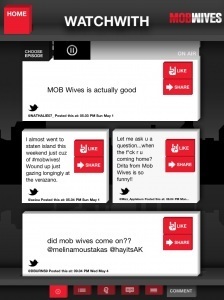


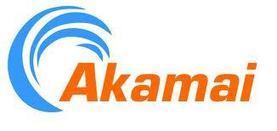
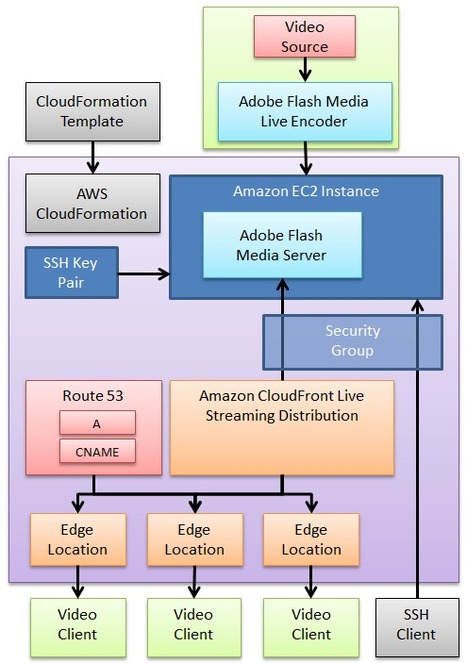
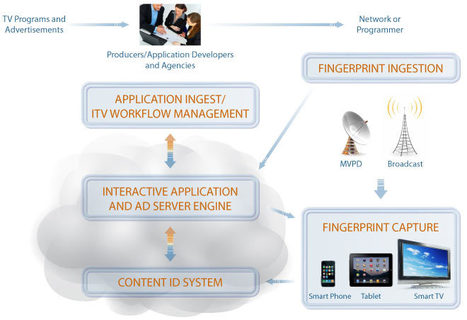
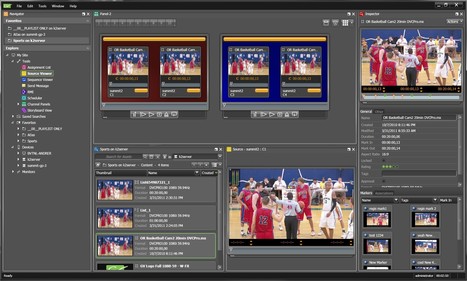
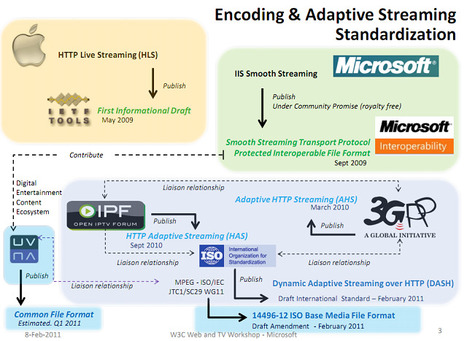

![Sharp Unveils World's First Super Hi-Vision HDTV [VIDEO] | Video Breakthroughs | Scoop.it](https://img.scoop.it/MAP0t7JQhwfyetIM9pz9Izl72eJkfbmt4t8yenImKBVvK0kTmF0xjctABnaLJIm9)



